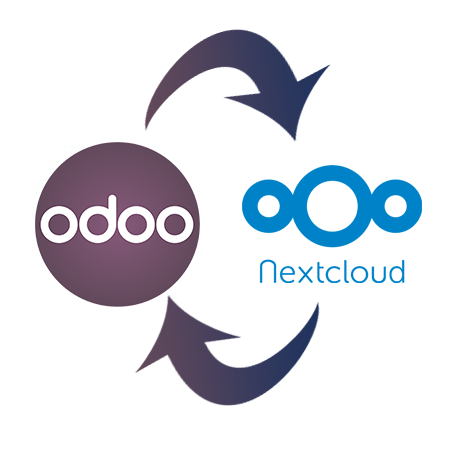
Nextcloud Connector für Odoo
Funktionale Erweiterung für die Dokumentenverwaltung von Odoo.
-
Freidefinierbare Ordnerstruktur für Kunden&Lieferanten, Verkaufschancen, Produkte, Personal
-
Smar-Buttons für Ablage-Mappen
-
Kategorisierung von Dokumenten und Datenmodellen
-
Synchronisation zu Nextcloud
Für Version: In der Regel ab Odoo 14 oder höher
Modulpreise auf Anfrage
Der Preis richtet sich nach der Anzahl der Benutzer. Unser Vertrieb unterbreitet Ihnen gerne ein individuelles Angebot.
Mit dem Nextcloud Connector haben wir die Möglichkeit geschaffen Odoo und die Nextcloud miteinander zu verknüpfen und Dokumente bidirektional auszutauschen. In Nextcloud wird eine übersichtliche Ordnerstruktur erstellt. Es kann direkt angemeldet in Nextcloud oder direkt aus Odoo heraus auf die Dokumente zugegriffen werden. Ebenso kann der Anwender in den Nextcloudordnern Dokumente hochladen, die dann in Odoo wieder automatisch verknüpft werden.
Das Modul Odoo Nextcloud Connector besteht aus dem Modul eq_cloud_base und eq_cloud_nexcloud. Das ist der technische Name für unser Modul. Das Modul haben wir selbstverständlich auch in unserem Modul Wiki für Sie dokumentiert. Der Mehrwert dieser App ist, dass sie bidirektional mit den Dokumenten in Odoo arbeiten können. Das heißt, Sie können Dokumente in beide Richtungen synchronisieren von Odoo in die Cloud und von der Cloud zurück in Odoo. Dabei wird automatisch eine übersichtliche Ordnungsstruktur angelegt.
Springen wir nun einmal in die Einstellungen für die Cloud. Der Vorteil von Nextcloud ist zum Beispiel, dass Sie eine eigene Cloud benutzen. Das heißt, das System wird auf Ihrem eigenen Server und nicht auf einem fremden Server gehostet. Somit liegen die Daten bei Ihnen auf Ihrem eigenen Server. Die Installation ist zudem recht einfach. Sie müssen hier nur die Zugangsdaten zu Ihrem Server hinterlegen, den Usernamen und Ihr Passwort als auch einen Rootfolder angeben, der nachher direkt auf Ihrem Server angelegt wird, um die Ordnungsstruktur anzulegen.
Setzen Sie außerdem den Haken in Aktiviere Cloud - ohne diesen Haken findet keine Synchronisation statt! Sie können dann über den Verbindungstest kurz checken, ob Ihre Verbindung erfolgreich ist. In dieser Anwendung läuft ein Dienst, der die Daten just in time zwischen den beiden Systemen synchronisiert. Wenn Sie sich an Ihrer nextCloud anmelden, sehen Sie auch schon, dass Daten in dieser Cloud hinterlegt wurden und der Rootordner angelegt wurde.
Sämtliche gängige Dateiformate, wie JPEG, Textdateien, Word oder Pdfs, werden vom Odoo Nextcloud Connector unterstützt.
Ein Dokument was z.B. einem Kunden in Odoo hinzugefügt wird, erscheint nahezu gleichzeitig auch im entsprechenden Ordner der Nextcloud. Ebenso anders herum: ein Dokument was in der Nextcloud hochgeladen wurde, erscheint kurz darauf auch im Kunden im Odoosystem unter Anhänge. Im Entwicklermodus sieht man außerdem den Cloud-Pfad. Über einen Smartbutton kann direkt ins OneDrive gewechselt werden.
Um Projektdokumente zu hinterlegen, benötigen Sie ein Zusatzmodul, welches eq_cloud_nextcloud_project heißt und die Synchronisation für alle Projektdokumente sowie deren Rootordner hinzufügt.
Der Konfigurationsaufwand ist sehr gering und es müssen keine Ordner mehr händisch anlegen werden.
Dies sind die wesentlichen Features der Odoo Nextcloud Anbindung für Odoo.
FAQ
Es wird ein Master-User im Nextcloud definiert. Dieser teile dann die entsprechenden Unterordner mit den anderen Usern über eine Freigabe in Nextcloud. Dies kann auch über LDAP gesteuert werden
Das Modul unterstützt verschiedene Datenmodelle wie Kontakte „res.partner“, Produkte „product.template“, Projekte „project“ etc.
Dort werden Grundordner Strukturen für reguläre Ausdrucke angegeben wie „Kunden + Lieferanten / [parent_id.name[:1]] / [parent_id.name] / Einkauf / Bestellungen / %(year)s“
Diese können dann angepasst werden. Nicht unterstützte Datenmodelle müssten über ein Zusatzmodul erweitert werden. Da die Grundfunktionen aber schon da sind, ist der Aufwand dafür meist überschaubar.
Rechte: Odoo selbst bringt ein Basis Rechtesystem mit – ebenso Nextcloud. In unseren Projekte wird dann ein gemeinsamer Nenner über LDAP hergestellt.
Das ist der von uns empfohlene Weg.
Odoo speichert im Standard die Dokumente in lokalen „Filestore“. Die Dokumente werden dazu base64 codiert. Die ersten 2 Zeichen werden auch als Ordner verwenden. Die Indizierung erfolgt in der Tabelle „ir.attachment“. Wir haben für die unterstützten Datenmodelle hier eine Weiche eingebaut. Entweder wird die Datei sowohl im „Filestore“ als auch in NextCloud gespeichert oder nur in NextCloud. Dies passiert JustInTime. Der Pfad wird im jeweiligen Datenmodell hinterlegt. Initial läuft ein CRONJOB und überträgt die bestehenden Daten ins Nextcloud. Der umgekehrte Weg funktioniert auch, wenn die Ordnerstruktur bereits in NextCloud von Odoo angelegt wurde. Der 2. CRONJOB gleicht die bestehenden Ordner mit Odoo ab.
Es gibt in jedem der Datensätze einen Smartbutton, der die direkte Verlinkung (Überordner) zu dem jeweiligen Dokument direkt in der Maske in Odoo ermöglicht. Im Entwicklermodus wird außerdem der Cloud-Pfad angezeigt.